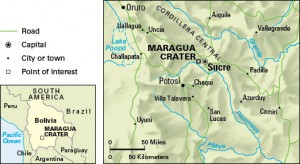Really Big Feet
Wednesday, August 17th, 2016August 17, 2016
Eons ago, a monstrous beast stalked an ancient South American floodplain. One of its enormous footprints in the soft clay was covered with layers of silt and was preserved for some 70 million years. Last month, the track was discovered, revealing that huge predatory dinosaurs lived in South America up until the extinction of the group about 65 million years ago.

The record-setting dinosaur footprint was found at Maragua Crater near Sucre, Bolivia, a site already known for other, smaller dinosaur tracks. Credit: WORLD BOOK map
Dinosaurs are a group of prehistoric reptiles that ruled Earth for about 160 million years. Most of these animals died millions of years ago, but their direct descendants—birds—continue to flourish today. Dinosaurs have fascinated people ever since they were first described in the early 1800′s as having strange appearances and huge sizes. Scientists now know that not all dinosaurs were large. Many, such as the microraptor and compsognathus, were, in fact, quite small.
The South American footprint, however, belonged to something gigantic with really big feet. It was found about 45 miles (60 kilometers) outside of Sucre, the official capital city of Bolivia, by a local tour guide. At some 45 inches (115 centimeters) wide, it is the largest carnivorous (meat-eating) dinosaur footprint ever discovered. The previous record was nothing to sneeze at either: a 40-inch (110-centimeter) wide track from New Mexico, a state in the southwestern United States.
The animal that made the South American print probably belonged to a group of dinosaurs called abelisaurids, large meat-eaters with short skulls and tiny arms that lived in South America, Africa, and India. Based on the enormous size of the footprint, scientists think the dinosaur could have been up to 40 feet (12 meters) long.
The discovery of this footprint helps paleontologists fill in the history of large meat-eating dinosaurs in South America. Giganotosaurus, one of the largest meat-eating dinosaurs known, stalked the continent some 95 million years ago. But Giganotosaurus probably died out after 5 million years or so, and paleontologists had not found fossil evidence of any large carnivores taking its place. The print was dated at 70 million years old, showing that abelisaurids took over after the demise of Giganotosaurus. With any luck, paleontologists will soon find the bones of these giant hunters and better understand the ecology of South America at the end of the age of dinosaurs.


